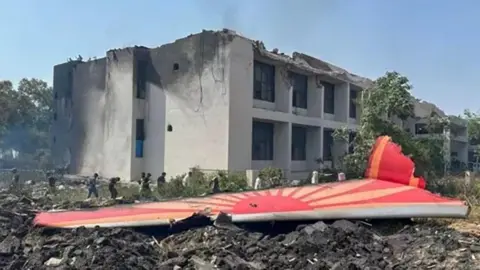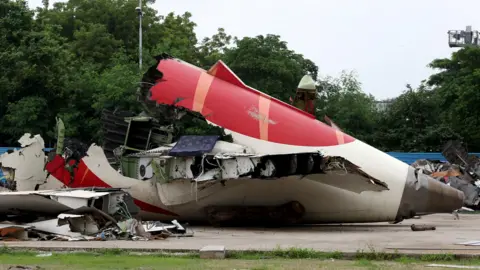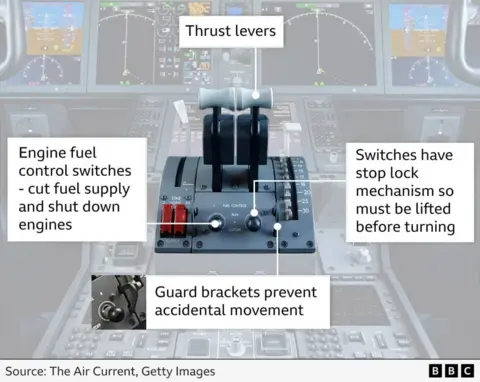International business correspondent
 Government of India / Ministry of Civil Aviation Aircraft Accident Investigation Bureau
Government of India / Ministry of Civil Aviation Aircraft Accident Investigation BureauWhile the preliminary report into what caused the loss of Air India Flight 171 last month has provided some answers, it has also prompted a wave of speculation about its cause.
The Boeing 787 Dreamliner crashed into a building less than a minute after take-off from the city of Ahmedabad in western India en route to London, killing 241 people on board, along with 19 on the ground. One passenger survived.
Information contained in India’s Air Accident Investigation Bureau report, the first official account of what happened, has raised questions about the role of the pilots.
However, experts within the aviation industry claim investigators have been highly selective in what they have chosen to say.
What the report says
Under international protocols, the state leading an air accident investigation is meant to issue a preliminary report within 30 days. The 15-page document published by India’s Air Accident Investigation Bureau (AAIB) on Saturday fulfils this requirement.
Although the AAIB has been leading the investigation, US interests are also represented, because Boeing, the maker of the aircraft, and GE Aerospace, the engine manufacturer are American.
The report does not set out any conclusions as to the cause of the accident. Nevertheless, it has sparked considerable controversy.
In its account of the accident flight, the AAIB states that two fuel cut-off switches were moved from the ‘run’ to the ‘cut-off’ position seconds after take-off.
This deprived the engines of fuel and caused them to lose thrust. Although data from the flight recorder shows the engines were subsequently restarted, it was too late to prevent the crash.
These switches are normally only used to turn the engines on before a flight and off afterwards. They have a locking mechanism, which means they need to be pulled out before being flipped, a system designed to prevent accidental deployment.
The report also states that one pilot asks the other “why did he cutoff”, while his colleague “responded that he did not do so”.
However, it does not provide any direct transcript of the conversation, which would have been picked up by the cockpit voice recorder (CVR). Nor does it identify which pilot asked the question.
It is worth remembering that preliminary reports are not intended to offer a full picture of what happened or draw firm conclusions. They are meant to be a factual summary of the information obtained in the early stages of what could be a lengthy investigation.
The investigating authority is also under no obligation to make their preliminary reports public.
 Reuters
ReutersMissing information
The information released so far has prompted a number of commentators to claim, in the media and online, that the accident was the result of deliberate and intentional action by one of the pilots.
It is a view that has attracted an angry response from the Indian Commercial Pilots’ Association, which warned that “invoking such a serious allegation based on incomplete or preliminary information is not only irresponsible – it is deeply insensitive to the individuals and families involved”.
It added that “to casually suggest pilot suicide in the absence of verified evidence is a gross violation of ethical reporting”.
In a memo to staff, the chief executive of Air India struck a similar note. Campbell Wilson warned against drawing “premature conclusions”.
Since the report was issued, the BBC has spoken to a range of people within the industry, including pilots, accident investigators and engineers. While theories as to what actually happened vary widely, the dominant view is that important information is currently missing.
“They’ve told us stuff they want us to know at the moment, and withheld what they don’t want us to know,” explained one pilot, who asked not to be identified. “It’s not a complete report.”
One of the main criticisms is the lack of a transcript from the cockpit voice recorder, which would enable the reported conversation between the pilots about the fuel cut-off switches to be put in context.
Bjorn Fehrm, an aeronautical analyst at consultants Leeham News said this was “totally unacceptable”.
“They have all this technical detail. Then you have this reference to dialogue, but it doesn’t even tell you who’s speaking,” he said.
Mr Fehrm was also concerned that there was no reference to what happened in the cockpit between the switches being flipped from run to cut-off, and the first switch being pushed back into position to relight the first engine 10 seconds later.
“It’s someone trying to hide something,” he said.

An engineering source, meanwhile, said the report was “very selective”, and did not have any detailed information about what the engines were doing immediately before the switches were flipped. The document does say that the engine speed began to decrease from take-off values “as the fuel supply to the engines was cut off.”
This, they said was important – because flipping the switches to cut-off and back was something a pilot would be trained do to in order to restart an engine that was already losing power.
Tim Atkinson, an aviation consultant and former air accident investigator in the UK said, “it is very disappointing to read a report which does provide a few salient facts, leaves many more questions”.
Another element of the report that has caused controversy is a reference to a safety bulletin – known as a Special Airworthiness Information Bulletin – published by the US Federal Aviation Administration (FAA) in 2018.
This was used to alert the aviation community that operators of some Boeing 737 models had reported cases in which the fuel cut-off switches had been fitted with the locking feature disengaged – potentially enabling the switch to be flipped by accident.
At the time, the FAA described this as an “airworthiness concern”, but said it was “not an unsafe condition” that would require mandatory action via what is known as an Airworthiness Directive.
Operators of a number of different Boeing models fitted with similar switches, including 787s, were advised to carry out simple inspections.
The investigation report says Air India did not carry out those inspections – prompting speculation that the accident could have been caused by faulty switches being flipped by accident.
However, in an internal note seen by the BBC, the FAA has since reiterated its belief that the issue did not compromise safety.
Engineering sources have also pointed out that the report says the throttle control module on the crashed aircraft was replaced on two occasions, most recently two years before the accident. This would have involved replacing the cut-off switches as well.
According to Bjorn Fehrm of Leeham News, the reference to the FAA’s advice contained in the report was “totally irrelevant” in the context of the accident.
Nevertheless, India’s Directorate General of Civil Aviation has asked the operators of all aircraft covered by the FAA’s original bulletin to carry out inspections by 21 July.
For former accident investigator Tim Atkinson, the vagueness of the report may have been deliberate – in order to suggest an explanation for the crash, while avoiding being too explicit.
“The very worst reports are those written to be read ‘between the lines’, and if that is what we have here, then it does no credit to the investigators,” he said.
Meanwhile those seeking firm answers to what happened on Flight 171 may well have to wait.
International protocols stipulate that a final report should be published within a year of the accident. However, in practice, it can take a lot longer than that.

